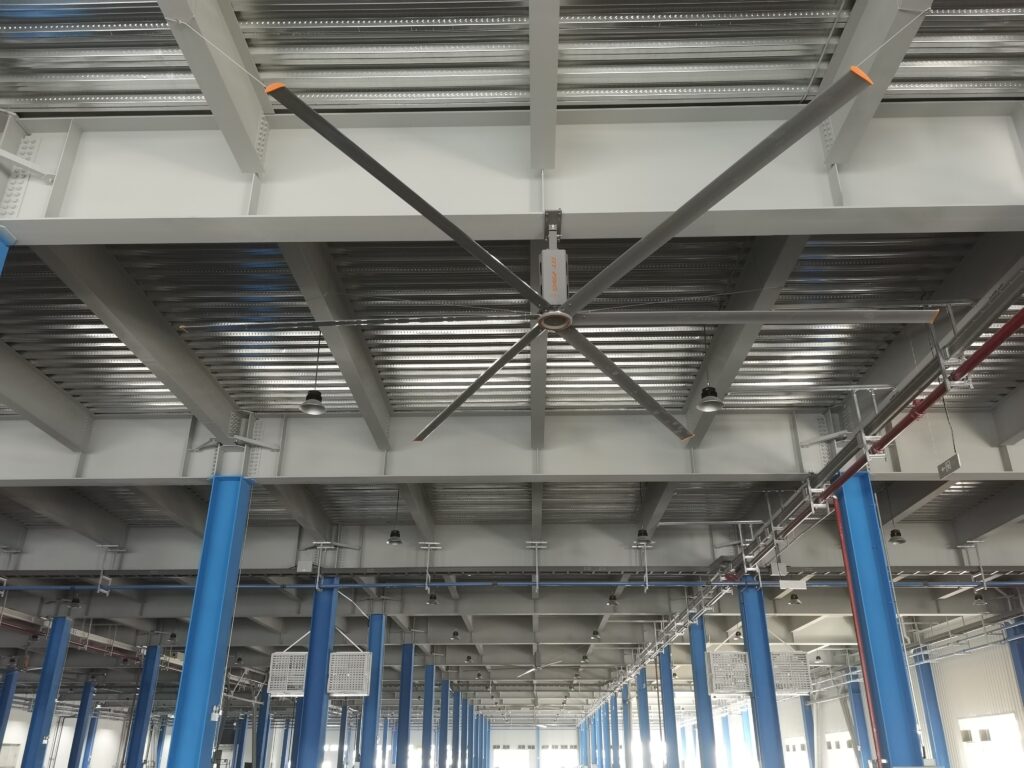Are you optimizing ventilation in large industrial spaces? Understanding how to calculate the coverage area of High Volume, Low Speed (HVLS) fans is critical for efficiency and cost-effectiveness. Let’s break down the science behind it, using RTFANS RTF-CF-7E industrial fan as a case study.
Key Factors Influencing Coverage Area:
1️⃣ Fan Diameter:
- 7.3m diameter: Covers 1,200–2,000 m² (ideal for warehouses).
- 6.1m: 800–1,000 m².
- 5.5m: 500–900 m².
Larger diameters deliver broader airflow with fewer units.
2️⃣ Installation Height:
- 6-8 meters height: The wind pressure is stronger and the coverage area is smaller, so the fan density needs to be increased.
- 9–13m height :maximizes coverage (+20–30%) for uniform airflow.
- >14m heights :Lower the installation height or use an extension pole, otherwise the coverage effect will be weakened.
3️⃣ Layout & Environment:
Ground obstacles (such as equipment and partitions) will limit the diffusion of airflow, and the number of fans needs to be increased. Open space can reduce the number of fans. For example, a 7.3-meter fan can cover 1500-2000㎡ when there is no obstruction.
The Math Simplified:
1️⃣ Theoretical Formula:
Coverage area = π × R² (R = effective radius).
Example: RTFANS 7.3m fan (radius ≈25m) covers ~1,963 m². Apply an 80% efficiency factor for real-world adjustments.
2️⃣Multi-Fan Layout:
The theoretical coverage area of three fans is three times that of a single fan, but this needs to be reduced appropriately due to overlap.
3x 7.3m fans can cover ~2,500–3,000 m² with 20–30m spacing to avoid turbulence.
Practical Recommendations:
1️⃣ Selection by application area:
For 2,000–3,000 m²: 3x 7.3m fans.
For 1500-2000㎡: 2-3 x 6.1m fans.
Below 1200㎡: one 5.5m or smaller diameter fan.
2️⃣Special scene adjustment
High-heat/humidity areas: Opt for higher airflow models (e.g., RTF-CF-7E: 13,800 m³/min).
Complex layouts: Add 10–20% more units to eliminate dead zones.
3️⃣ Importance of professional assessment
It is recommended to contact the supplier for on-site assessment and customize the solution based on the specific height, obstacles and ventilation requirements.
Case Study:
A 2,500 m² steel-structured facility (10m height, no obstacles):
1x 7.3m fan ≈1,440 m² (after 80% adjustment).
Solution: 2 fans spaced 25–30m apart.
✅ Why Partner with Experts?
Brands like RTFANS offer tailored assessments to factor in height, obstacles, and environmental needs. RTF-CF-7E model exemplifies precision in balancing coverage and energy efficiency.
Pro Tip: Always validate calculations with on-site evaluations for optimal results.

